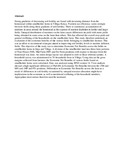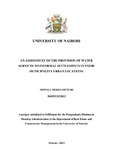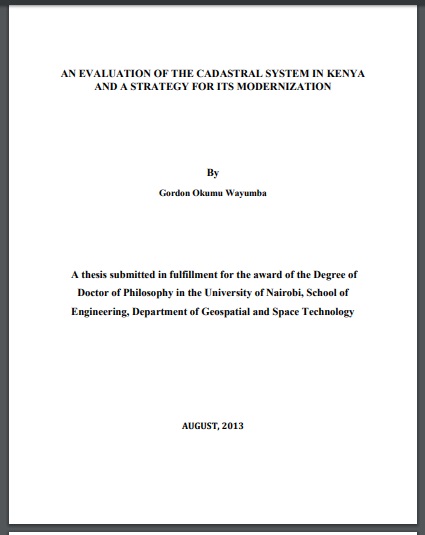Location
Our Vision is to be a world-class university committed to scholarly excellence.
Our Mission is to provide quality university education and training and to embody the aspirations of the Kenyan people and the global community through creation, preservation, integration, transmission and utilization of knowledge.
Core Values
In order to realize the above vision and mission, certain shared values shall be nurtured. There is great need for the University to be guided by the right values derived from the virtues and moral standards of the Kenyan and wider society.
Core Functions
Teaching and Learning: The university offers innovative , relevant and market driven academic programmes , both at undergraduate and postgraduate levels with inbuilt quality control systems the university also provides an environment and policy framework for undertaking high quality and relevant research
Members:
Resources
Displaying 86 - 90 of 298Nitrogen Fixation by Natural Populations of Acacia Senegal in the Drylands of Kenya Using 15N Natural Abundance
Nitrogen (N) fixation was estimated for three Acacia senegal (L.) (A. senegal) Willd. varieties (A. senegal var. senegal, kerensis, and leiorhachis) growing naturally in different sites in the dryland areas of Kenya. The quantities of N2 fixed were estimated by the 15N natural abundance method, using leaves as the sampling material. Balanites aegyptiaca (B. aegyptiaca) was selected as the reference species growing in the same area. Soil samples were also collected under A. senegal trees for nodule assessment. Leaf 15N natural abundance values (δ15N) were significantly different between A.
Evaluation of the Economic Net Benefits of the various fields found on a smallholder farming system in Vihiga-Kenya
Strong gradients of decreasing soil fertility are found with increasing distance from the homestead within smallholder farms in Vihiga-Kenya. Nutrient use efficiency varies strongly between fields along these gradients of soil fertility. There is continuous accumulation of nutrients in areas around the homestead at the expense of nutrient depletion in further and larger fields. Unequal distribution of nutrients on the farm causes differences in yield with more yields being obtained in some areas on the farm than others.
Variations in Land Delivery Costs as a Factor in Land Speculation in Metr opolitan Nairobi: A case study of Eastlands, Nairobi, and the bordering areas of Machakos and Kajiado counties
The urban rural duality in the land administration policy in Kenya tends to create two land use development control models and, further, such policy results in two separate land transaction costs. In a situation where land values in the two locations may not vary significantly, such a variation in land transaction costs would lead to land speculation in the less costly zone. It is postulated in this paper that there would be no significant variations inland sale value/ land purchase price in the areas of Eastlands within the
An assessment of the provision of water services to informal settlements in nyeri municipality urban locations
The main aim of the study was to examine water provision in informal settlements in Nyeri town. The objectives of the study were; to identify the current water sources in Nyeri‟s informal settlements, assess the current levels of mains provision in the informal settlements, to identify and suggest ways of ensuring a sustainable method(s) of providing water services to the informal settlements within the municipality. The provision of this crucial service particularly in informal settlements is a major challenge and cannot be expanded at the desired rate.
AN EVALUATION OF THE CADASTRAL SYSTEM IN KENYA AND A STRATEGY FOR ITS MODERNIZATION
The Cadastral system in Kenya was established in 1903 to support land alienation for the white settlers who had come into the country in the early part of the 20th Century. In the last hundred years, the system has remained more or less the same, where land records are kept in paper format and majority of operations are carried out on a manual basis. The lack of a modern cadastral system has contributed to problems in land administration in the country.





